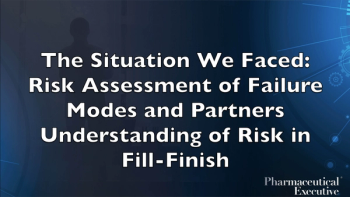
Developing Drugs for Rare Diseases: Insights for Pharma Execs
This article explores the difficult nature of developing drugs for rare diseases and discusses what a pharmaceutical executive can actively do to help increase success.
When the first gene therapy was approved in the US on August 30, 2017, not only did it usher in a new approach to treating cancer and serious life-threatening diseases, it also affirmed the desire of the US Food and Drug Administration (FDA) on improving therapies for rare diseases, including treatments for children. FDA Commissioner Scott Gottlieb offered inspiration in remarks accompanying the approval, noting the FDA was committed to doing its part to help advance breakthrough science to certain patients who are not served well by conventional therapies. While there are still many challenges in drug development for rare diseases, knowing the FDA has committed its support to this area is encouraging and could counter the skepticism and the setbacks that biotech companies may encounter on the road to approval.
The FDA has demonstrated a generous interest in championing the development of novel therapies by creating important incentive programs, while maintaining compliance, particularly for small pharma/biotechs working in rare diseases. These incentives include orphan drug, rare pediatric disease and breakthrough therapy designations, and also the new regenerative medicine advanced therapy (RMAT) designation, each of which offers specific benefits. For example, orphan drug designation provides seven-year US marketing exclusivity from launch, as well as tax credits and other benefits including waiver of the Prescription Drug User Fee Act filing fees. The rare pediatric disease designation specifies that once a drug has been approved, the company becomes eligible for a rare pediatric disease priority review voucher that can be used to obtain priority review for a subsequent New Drug Application or Biologics License Application or can be sold to another company. This incentive is significant and a tangible benefit for a small company whose revenue model may require years to achieve profitability. Furthermore, the new RMAT designation can expedite approval of novel therapies that address the unmet medical need of a rare disease.
In addition, the FDA has been receptive to having a pre-Investigational New Drug (IND) application meeting which serves as the company’s prime opportunity-before any designations have been assigned-to ask questions and use the Agency’s feedback to develop the IND package for its product candidate, including pre-clinical model selection, manufacturing approach, and clinical trial protocol design.
Mapping Out Key Points on the Road to Success
There are a variety of challenges along the road to approval of any novel therapy for a rare disease. Nevertheless, there are several ways a pharmaceutical company can increase the potential for success and mitigate setbacks.
First, it is critical to determine an appropriate and achievable target that can position the company for success. According to the National Institutes of Health, there are approximately 7,000 rare diseases with many requiring a therapeutic solution; however, targeting a rare disease with a complex or unknown mechanism of action may be difficult as expression of multiple proteins at specific intervals could be required. Conversely, identifying a target that is monogenic and represents an unmet need provides a manageable entry into gene therapy development.
Another way to help ensure success early on is to take a different approach to developing the animal model. As with any drug candidate, the pre-clinical work must assess toxicology and pharmacology in animal models. However, the challenge with rare diseases is that these models typically do not exist or suffer from a lack of research. To make up for this shortfall, it is vital to collaborate with experts in the disease. The goal is to demonstrate how the disease can be addressed in ways that have not been shown in existing models and in a manner that will meet regulatory requirements.
When moving into the clinical stage, an important decision must be made to select the best endpoints that can be used to gauge success. With well-studied diseases, there typically exist established, easily measured, approved endpoints on which a company can model its clinical program. Such endpoints, unfortunately, are often lacking in rare diseases due to no or few clinical successes. It is therefore critical to work with experts to determine what outcomes are most important and how to measure them. Is there a specific biomarker? Is there a protein or physical change in an organ, skin, or blood that can accurately be measured and has been linked to a significant change in the disease which is cited in medical literature? Or, are there any other clinical outcomes associated with the disease, such as a change in quality-of-life, that can be evaluated. In fact, some personalized measurement approaches require drug-diagnostic co-development. Any such measure (or a combination of both biomarkers and clinical outcomes) that can be developed in the earliest stages of a trial-and subsequently validated-can help with measurement of outcome success. Furthermore, knowing if there have been studies conducted to chronicle the course of the disease over time, determining whether it is chronic or not, and outlining its general attributes are important questions to answer. It should be no surprise that the more pharmaceutical leaders are familiar with the course of the disease, the better the guidance will be for developing a therapeutic solution.
Even so, there is another challenge with rare diseases, as often no existing natural history exists due to small patient populations. Frequently, companies turn to advocacy groups for support to learn more about the disease.
Advocacy Plays a Critical Role
It is important to recognize that advocacy plays a larger role in rare diseases than in other indications. Corporate participation in advocacy groups’ educational forums offers opportunities to interact with patients and their families and gain further insight into the disease and its impact on their lives. Moreover, advocacy groups can be instrumental in building awareness among and communicating with the patient community on a variety of topics, ranging from the status of clinical trials and enrollment criteria to upcoming events and support services. It is essential to recognize that there is a threshold for corporate involvement with advocacy groups; companies must balance working with them while maintaining compliance.
Start working with advocacy groups early in the drug development process, because they can offer valuable insight that the company can consider for modeling and determining endpoints. Advocacy groups have intimate knowledge of what is important to patients and families and can provide answers to questions, such as: What is the most taxing aspect of the disease? What is a patient’s day like? In addition, they can address economic issues and concerns associated with patient care and these responses can be useful when the company develops pricing and reimbursement models.
Furthermore, having a positive relationship with advocacy groups can help build trust with the rare disease patient community, particularly as this field has shifted to personalized medicine. A trusting relationship facilitates an open dialogue and helps a company to be well-prepared to answer patients and families’ tough questions about potential treatments while learning about their quality-of-life issues and caregiving concerns. As state-of-the-art treatments have become more complex, so too has the knowledge and curiosity of patients and their families. Therefore, it is increasingly important for advocacy groups to convey the novelties about new therapies to their members; likewise, it is essential for companies to be transparent about their treatment approach, while also recognizing what information can be publicly disclosed-particularly when the company is public. Advocacy groups can be a strong, influential corporate ally because their motivation, as well as that of the pharma/biotech companies is to find solutions for treating rare diseases and supporting the patient community.
Overall, there appears to be a greater appreciation of the symbiotic relationship between companies and advocacy groups than there may have been in the past.
Families and Social Media
Patients living with rare diseases and their families are very well informed-obtaining educational information about the disease, clinical trials, new treatments, and resources from advocacy websites, patient blogs, and other social media outlets, including Facebook and Twitter.
Social media allows patients to connect with each other and can also be an effective communications tool for companies developing therapies for rare diseases. It allows companies to share public information about their drug candidate’s progress and to make timely news accessible to rare disease patient communities.
For commercial products, traditional communications’ vehicles, like newsletters, can continue to be utilized, as well as marketing programs and a sales force. However, these tools can be augmented with social media to extend the reach of communications.
Key Opinion Leaders and Patient Registries
It is vital for companies focused on rare diseases to work with world class experts. These Key Opinion Leaders (KOLs) can assist with many aspects of drug development, ranging from aiding in the design of animal models to establishing clinical endpoints. To get KOLs onboard means convincing them that the company is working with patients’ interest in mind and that their “expert” role is critical to the program’s success. From the outset, a company should convey its vision and confidence in developing a new therapy, the potential to obtain approval of the drug and the plan to scale-up for commercial manufacturing.
Before contacting an expert, it is important for the company to determine a KOL’s role and responsibilities, i.e., whether to be a member of the company’s scientific advisory board, a consultant, or a principal investigator. Making these determinations upfront and then communicating them to the KOL will help the individual make an informed decision about participating in your program. Being transparent about the opportunity also fosters trust from the start of the relationship.
Finally, companies working in rare diseases should seek access to patient registries. Since rare disease populations are small, it is often a challenge to recruit a sufficient number of patients for a clinical trial. If a patient registry does not exist for a rare disease, a company should consider supporting the creation of a registry which could be done in conjunction with a natural history study and prove to be an invaluable long-term resource.
Overall, although the challenges of developing therapies for rare diseases may be daunting, the potential rewards could be remarkable for the pharma/biotech industry, and more importantly, transformative for the patients and families who suffer from these conditions every day.
John Maslowski is president and CEO of Fibrocell Science, Inc., a gene therapy company focused on transformational autologous cell-based therapies for skin and connective tissue diseases.
Newsletter
Lead with insight with the Pharmaceutical Executive newsletter, featuring strategic analysis, leadership trends, and market intelligence for biopharma decision-makers.





